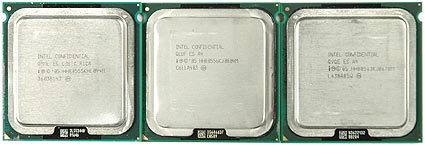Quad-Core Xeon Clovertown Rolls Into DP Servers
More Cores = More Power?

Left to right: Dempsey (3.73 GHz NetBurst dual core), Woodcrest (3.0 GHz Core 2 dual core), Clovertown (3.0 GHz core 2 quad core).
In general, the statement "more cores equal higher power requirements" is true. There are more transistors that need to be operated, and if the CPU is working at high loads it will require considerably more energy. However, all modern processors come with built-in power saving mechanisms. AMD calls its technology Cool and Quiet, while Intel offers SpeedStep in the desktop and mobile segment and DBS (Demand-Based Switching) for professional products.
The power saving functions work in a similar way; they require BIOS and operating system support and usually a processor driver. The driver monitors the system workload and has the processor reduce both its core clock speed and its operating voltage if there is little work to do. As soon as the OS demands performance, the clock speed increases. AMD's Cool and Quiet offers several clock speed increments while Intel's SpeedStep allows only two clock speed levels: max and SpeedStep speed. We don't favor one technique over the other, as advantages and disadvantages vary with your particular environment. In any case, make sure your Cool and Quiet or DBS feature is enabled - it will save energy and help with system cooling and air conditioning in large-scale system environments.
As the core count increases, there are even more options that allow you to save power: Processors may shut down individual cores or unused cache segments. Intel's 65-nm products mostly use energy-saving clock gating or so-called sleep transistors that do not require energy when idle (in sleep mode).
Be prepared to see quad-core machines consume more power and dissipate more heat under high loads versus a dual-core system. This is very acceptable as you will receive a performance increase that is unprecedented. And the equation makes sense: If your system heat dissipation and power consumption increase by 15-20%, but your processing time for a demanding workload decreases by 15-40%, the system might be able to jump back into a lower power state much faster, where it doesn't consume noticeably more energy than the dual-core machine - which, being much slower, would remain at a high power consumption level for a long period of time.
Xeon processors typically are rated at a design power of 65 W or 80 W, and all quad-core Xeons (1.6, 1.86 and 2.33 GHz) do not exceed this power rating. Only the 3.0 GHz top model requires a platform that can cope with 120 W per processor.
Multi-Core Bottlenecks
If you want a high-performance device to be efficient you will need fast data paths. In terms of fast 3D graphics solutions, supercharged graphics memory is imperative. If we have a look at processors, it's the interface that can become a bottleneck, especially with the Intel architecture. All AMD processors that are available today have a built-in DDR or DDR2 memory controller, which means that there is virtually no data path if the processing cores need to access data. Intel solutions still rely on a memory controller, which is part of the platform core logic, and although Intel has upgraded its Xeon platform with Dual Independent Front Side Busses for each processor and a quad-channel DDR2 memory controller, the data path is still shared by all available cores.
Stay On the Cutting Edge: Get the Tom's Hardware Newsletter
Get Tom's Hardware's best news and in-depth reviews, straight to your inbox.
This makes the whole thing a bit tricky: Can you image two eight-core processors fighting for a single set of RAM? AMD cannot, which is why each processor uses its own memory. Yes, there might be coherency issues if one processor accesses data that is located in the other processor's RAM or L2 cache, but the final result is considered very much acceptable. In addition, future operating systems will be aware of physical processors (Windows Vista Ultimate Edition), so they can assign thread or application workloads to one specific processor only, helping to create a smart way of load-balancing the work. This applies both to Opteron and Xeon platforms, but may still be more beneficial for the AMD solution.
Current page: More Cores = More Power?
Prev Page Clovertown Moves Quad-Core CPUs Into DP Servers Next Page Intel Xeon 5300 Aka Clovertown-
Should I buy one of these xw8400 Workstation Dual Xeon Dual-Core 5160 3.0GHz and put a good card in it?Reply